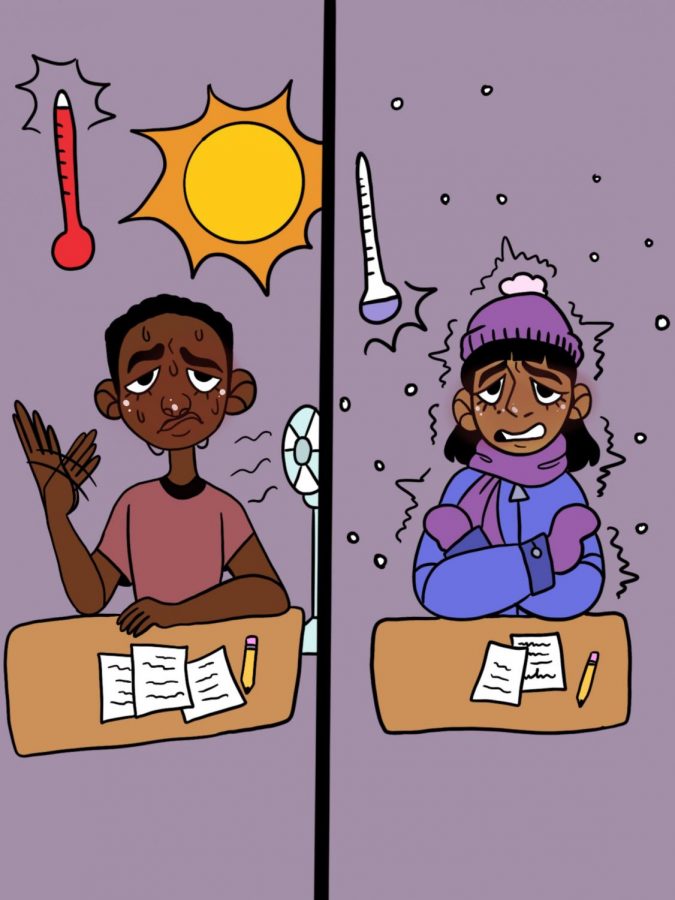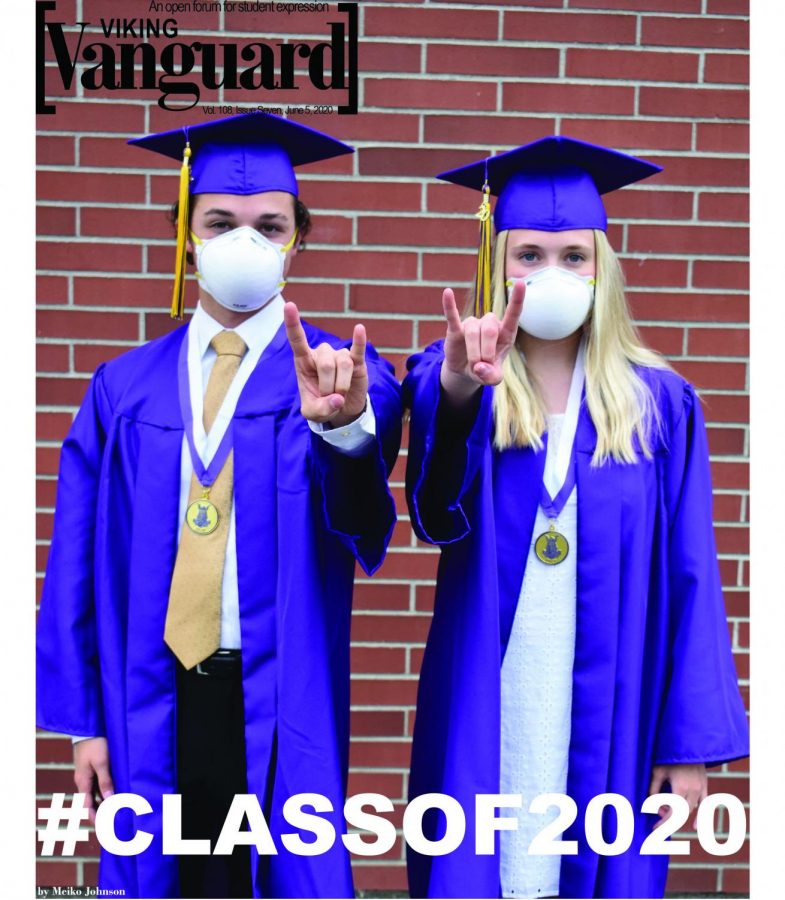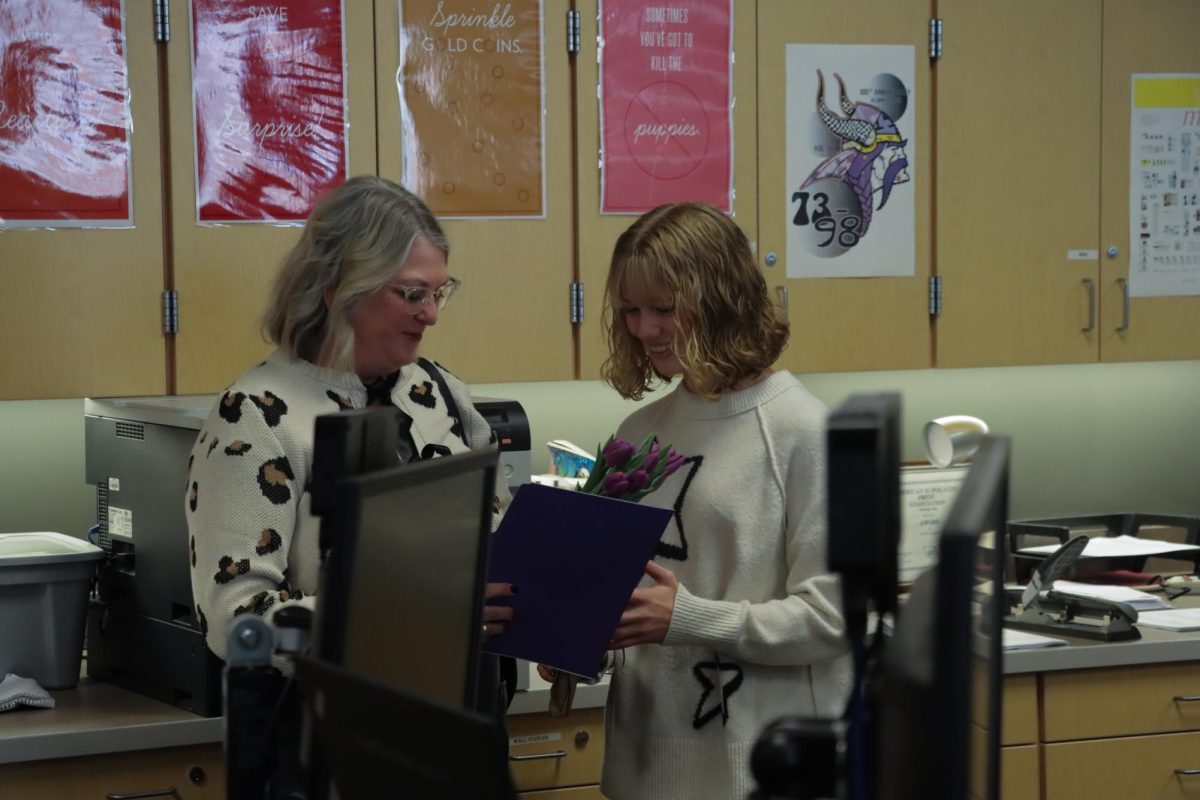A whoosh of humid air rushes through the open window.
The humming of the numerous fans fill the fifth period silence.
Sleepy eyes sprinkle the classroom. Lethargic movements become the pace of the room.
As the cold weather sets in, the differences between classroom temperatures grow. The contrast of the second floor gym building rooms to the second floor main building is very different. One area can be frigid and the other humid and stuffy.
English teacher Sara Waters is a prime example of this temperature change. Her room, 208, ranged from 68 to 85 degrees up until the H-VAC (heating, ventilation and air conditioning) system malfunctioned.
“Up until [recently], it had been all over the place. Since the weather cooled down it’s usually in the high 60s in the morning, around 68 or so and usually right around lunchtime is when it gets up to about 80 degrees,” Waters said. “During fourth, fifth and sixth period it just seems to get progressively get hotter and hotter. It has gotten up to 93 in here.”
Junior Ryan Jones says he has experienced the sensation of ‘melting’ in Water’s classroom first hand. He has her for fifth period and realizes there’s a problem at hand.
“Getting a classroom to 90 degrees is pretty bad on an already hot day. That happens quite frequently,” Jones said. “It’s also annoying that it doesn’t get fixed. It just gets hotter and hotter. It’ll get gradually worse until something breaks.”
Craig Fredrikson teaches math in room 250, which is on the second floor of the gym, an area notorious for extreme temperatures. This is his sixth year in that space at PHS and likes it except for the heating and cooling problems.
“The temperature issues are strangely backwards periodically, so for instance in the spring last year, and in previous years, when it was hot outside the heat was on and in the winter when it was cold outside the air conditioning was on. That’s a logical flaw to me right there,” Fredrikson said.
These extremes have affected the way he teaches. It’s causes his lessons to be disrupted and even results in relocation.
“The most drastic [affect on my teaching] is an actual move where I took my classes to the commons because it was too cold in [my room]. I literally walked in one morning and saw my breath in my own room because it was so cold. That’s not good for learning,” Fredrikson said.
Jones has been affected by both hot and cold rooms. He also has observed the effect it has on his fellow students.
“When it’s warm out, I know for my friends, sometimes they get headaches [in class] and I know I’ve gotten a few headaches when it’s warm out. When it’s cold, it’s a different story. It’s just you’re cold. It does inhibit your concentration a bit. I think it’s just another distraction,” Jones said. “People start complaining about it and it just makes students talk more. [If] there’s an issue actually going on in the classroom like a weird smell or temperature, kids are going to be talking about it and they’re going to keep talking about it and keep bringing it up and complaining, therefore distracting others.”
The teachers also notice these effects. They’re not oblivious to what goes on among their students.
“When it’s hot, it makes people sleepier and less aware. It’s just not comfortable in the room when it’s hot outside or cold outside,” Fredrikson said. “They get sleepy on the hot days. The cold days I’ll see some of them shivering. They definitely don’t react well as far as [it] being good for their education. It’s not horrendous, we can all tough it out but it’s not conducive to learning.”
Not only are the students influenced by the condition, but the teachers as well. They may hide it more but it’s just as affecting.
“During the times of it getting up to 90 degrees, pretty much every single day, I would just be so exhausted by the end of the day. It’s difficult to be standing and walking around the room and trying to focus on students for hours at a time when it’s that hot,” Waters said. “Also the students really feel it, especially by fifth period or sixth period. Towards the end of the day, when it’s that hot in here students just lose their focus.”
According to Cambridge Brain Sciences, as temperatures rise, cognitive performance decreases and mental effort declines.
Mario Casello has been working for the school district as a principal for the past 21 years. Five years ago he assumed the role of Chief of Operations for the District. He is in charge of ensuring that they’re fulfilling their mission “to plan for, build, maintain and improve [their] school properties in a manner that supports academic success, safety and comfort to the users and community pride in appearance”. He wants people to realize the decisions the district had to make when getting H-VAC systems.
“It’s a complicated process. Here’s the deal. We live in the Pacific Northwest and we have temperatures; our normal temperatures are anywhere between 40 degrees and 75. We don’t typically get super cold temperatures, down in the teens or low twenties. We don’t typically get really hot 90 degree, 100 degree weather in the Pacific Northwest,” Casello said. So when we talk about our region and you talk about manufacturers that design and make H-VAC systems, they really design the ones for the Pacific Northwest to meet kind of those normal temperature ranges between 40 and 70-75 [degrees].”
The district has to find the right system for the Pacific Northwest, which can be a challenge in itself.
“We don’t buy the type of H-VAC system that you would get in Arizona, because they’re really designing those, and using ones that are, you know, supposed to be for really hot temperatures, in the 90s and 100s. We don’t get an H-VAC system that they would use in Alaska that’s for really cold temperatures down in the teens and below temperatures,” Caselllo said.
The district has to cater to the average temperature of the region. If there’s a year or two that are above or below the average, that would cause the system to malfunction.
“We are using a system that’s trying to be in that middle range. And so when it does get really hot here, we get a spike of 90 degrees or 95 that H-VAC system doesn’t adjust well to going from what it’s designed to do, be in the 60s and 70s or 50s. And now all the sudden you got to perform when it’s 95 degrees. And a lot of times, it’ll go offline or get kicked off line, or if it gets super cold, like we’re getting ready to enter into winter season,” Casello said. “Well if it drops down to, you know, 14 [or]15 degrees, a lot of our systems kind of get, you know, alarmed and they’re like, oh, what am I supposed to do, and it gets kicked off the system and it needs to be reset. So when that happens, that’s when we experience really cold classroom, or will experience a really hot classroom in the spring or summer.”
There’s a lot behind the scenes that the general public doesn’t always see. An H-VAC Technician is required to go out and physically check out the system and reset it.
“People don’t realize that, and our H-VAC systems are on a computer system so they’re monitored by the computer. Well there’s times I’ll get a call from Mr. Sunich at Puyallup and he’ll be like oh room to 217 is like 55 degrees. Well the computer will say, no, it’s, you know, 70 degrees or 69 degrees and H-VAC Tech has to go in and reset it then for it to kind of get back to normal,” Casello said.
Jones is confused as to why this is still a problem. He feels students shouldn’t have to spend time focusing on preparing for class temperatures rather than the actual school work.
“You think they would fix it but they don’t and I don’t know why they don’t. It’s not positive for our classroom environment to have this overly heated or freezing temperatures in our classrooms. If they expect us to do [well] on [our] school work, they need to give us an environment where we can actually work and not an environment where we have to worry about [preparing for the temperature],” Jones said.
We are in a very large district. Casello says he wants to be able to solve all the problems but it’s just unrealistic.
“Our district is [big], we’re the eighth largest district in the state of Washington. We have almost 23,000 students and we got over 3,000 employees. We have 32 schools, and we got another 15 support sites. [For] all of that we have literally a day H-VAC foreman; one guy performing during the school day from seven in the morning till 2;30 at night, we have one H-VAC foreman, and we have one tech now that we just hired, that can go and troubleshoot all those H-VAC concerns. And then we have one H-VAC guy at night,” Casello said.
There are a lot of H-VAC systems in the district and so the task of checking up on all of them can get overwhelming at times.
“You can imagine the challenge that we have in trying to manage all that or keep on top of it. It’s virtually impossible. We will never ever be ahead on dealing with our temperature issues, because we don’t have the staff available for [the] size [of our] district to do preventative maintenance, that’s what we need to do is preventative maintenance on our H-VAC systems, and we can’t do that. We only got three four guys that can address any H-VAC issues,” Casello said.
Waters has seen a change in the system in her room’s temperatures but only because of the fire scare. This change hasn’t transferred to her neighbor classrooms.
“Since we had the emergency, we did have two H-VAC technicians come in and address the issue and it’s been pretty pleasant in here since then…I’m still waiting to see it’s going to last since this has certainly been an issue even in other rooms that I’ve been in on the same floor,” Waters said.
Waters knows that her situation wasn’t ideal, but it ultimately led to a positive change in the classroom. She realizes that others in the school aren’t as “lucky”.
“I guess I was lucky enough that things got to the point where my room filled up with stinky, toxic smoke but my neighbor next door, Mr. Taren, has not had anybody address the heating issues in his room from what I’ve heard from him, he has no air coming through his vents at all,” Waters said. “So the technicians did come in and they fixed my room but I guess they were not sent to go next door and fix his problem as well.”
Jones has had a class relocated because of a broken heating system. He knows that teachers shouldn’t have to plan to be relocated for a lesson.
“Waters’ [classroom]. It got so bad that something actually broke and inhibited our learning because we had to go to another classroom for the day. Luckily, her [class plan] was able to go with that but if it was another scenario, it might not have,” Jones said.
About a month ago Waters’ classroom had an H-VAC system malfunction which Jones mentioned. She had observed some suspicious signs before the mishap occurred.
“Other classrooms in this same hallway, in particular, are having that problem of it getting very hot. This was all before things finally caught on fire up above my classroom, which I had informed people ahead of time, back in September, that there was a smell of burning plastic in here,” Waters said.
Soon the signs grew resulting in a school evacuation and District action to take place.
“I don’t think it’s the heat in the room that caused it. I think the mechanics of what’s in the H-VAC system above this room was not functioning and it finally got to the point where some of the bearings in there, they didn’t exactly catch on fire [but] they were smoking,” Waters said. “The indications of that, before it got to the point where my room filled up with smoke and we had to evacuate the building, was when there was the smell of burning plastic in here previously and that the temperature regulation was nonexistent.”
Casello realizes that the situation seemed very extreme, but in reality it wasn’t as big as some had made it seem.
“Let’s be honest, [system malfunctions are] normal because it’s the mechanical system, and it has basically a lifetime, and when some of these systems get old, they’re [20 to 30] years old, we start experiencing [burn outs] like that. That was not as scary as everybody thought it was. It was a burnt up motor that then created this smoke and that’s what led to us having to evacuate or close that area [of the school] down,” Casello said. “That happens and we just address them and we got to put a new motor in it and so it doesn’t change how we do things it’s just kind of a normal operational thing we got to deal with.”
Fredrikson figures that the system they installed back when the school was built was not built for extreme temperatures. The amount it would cost to replace all of these systems is greater than the District wants to pay.
“There are a lot of reasons why it hasn’t been fixed. I think the biggest reason is [that] it’s going to take to much money and especially when they’re hoping to rebuild a new gym. It’s not very logical to invest a bunch of money in fixing a heating and ventilation system when you’re already going to tear the building down in a couple of years,” Fredrikson said.
Fredrikson’s speculations are not far off. It costs a lot of time and money to be able to regulate the temperatures of the district classrooms.
“Here’s what people say, ‘Well, go hire a bunch of H-VAC people.’ It comes down to money. Do have enough money to be able to hire and employee more H-VAC people? Then the second thing is, can we even find H-VAC people that want to leave the private sector and come into something like public education where we can’t compete with salaries that they make in the private sector? Yeah,” Casello said. “If you’re an H-VAC guy you’re making a ton of money being out in the private industry, versus what you do in public education working for a school district. We had an H-VAC position posting that was open for nearly two years, we could not find anybody that would come here to want to work for the salary that we could offer. Two years that position was open. That’s a long time.”
Fredrikson hopes that the District learns from what PHS has experienced. He wants them to avoid making the same mistake in the future.
“You can’t reverse the past, you can only invest money correcting the future. I don’t anticipate they’re going to fix any of the old buildings, I would hope that any new building or any new remodels have the proper ventilation,” Fredrikson said.








